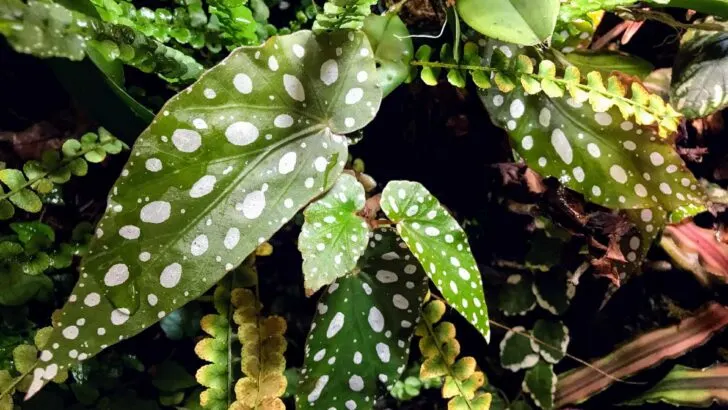You are reading this article to learn more about Begonia maculata care and the plant itself. I care for this species for serveral years now, both in a terrarium and as a regular houseplant. Here is what you need to know.
Begonia maculata care Takeaways
| Species | Begonia maculata |
|---|---|
| Synonyms | Polka Dot Begonia, Spotted Begonia, Clown Begonia |
| Family | Begoniaceae |
| Genus | Begonia |
| Growth | Upright, bushy |
| Height | 2ft / 0.6m |
| Width | 1ft / 0.3m |
| Soil | Well-draining soil mix |
| Watering | Every 7 – 14 days |
| Light | Bright indirect light |
| Temperature | 65 – 80°F / 18.3 – 26.7°C |
| Humidity | 40 – 60% |
| Fertilizer | Once a month |
| Propagation | Stem cuttings or leaf cuttings |
| Toxicity | Toxic to humans and animals |
Begonia maculata Plant
Begonia maculata goes by the botanical name Begonia maculata var. wightii. It is a fibrous-rooted upright Angel-Winged cane Begonia. Indoor and outdoor gardeners love these perennial cane Begonias with white polka dots. But let’s face it, the care can be tricky.
It is rumored that Christian Louboutin created his trademark red-heeled shoe to mimic the red leaf undersides of the Trout Begonia. So, it shouldn’t be surprising to hear that this plant requires specialized attention and care.
According to RHS, it is commonly called the Polka Dot Begonia or Spotted Begonia. It derives its name from its unique silver spotted leaves and red undersides. The leaf blades have silver polka dots on the upper side.
Begonia maculata care
The Begonia maculata prefers well-draining soil and bright indirect light and should be fertilized monthly. As for watering, let the soil dry out before each watering and adjust according to weather conditions. Optimal humidity is 50% and more, and temperatures should be between 65 – 80°F (18.3 – 26.7°C).
Table of Contents
According to the University of Florida, the Begonia family comprises more than 1300 species and hybrids.
Spotted Begonia Care Video
Begonia Maculata Plant Care Guide
Begonia maculata prefers well-draining soil, bright indirect light, and should be fertilized every month. As for watering, let the soil dry out before each watering and adjust according to weather conditions. Optimal humidity and temperature levels between
The Best Soil Mix For Angel Wing Begonia
Begonia maculata wightii does very well in an acidic potting mix of sand, clay, and loamy soil inside a pot with good drainage. This plant prefers slightly moist but never soggy soil. Alternatively, use a coco coir mix.
This plant is highly susceptible to root rot. As such, it is always best to add a layer of pebbles or broken pieces of terracotta pots to the bottom for better drainage. You can also use wood chips to lighten up the soil.
The root ball should never be in soggy soil for too long.
Repot the plant in a bigger pot twice its previous size once it becomes root-bound.
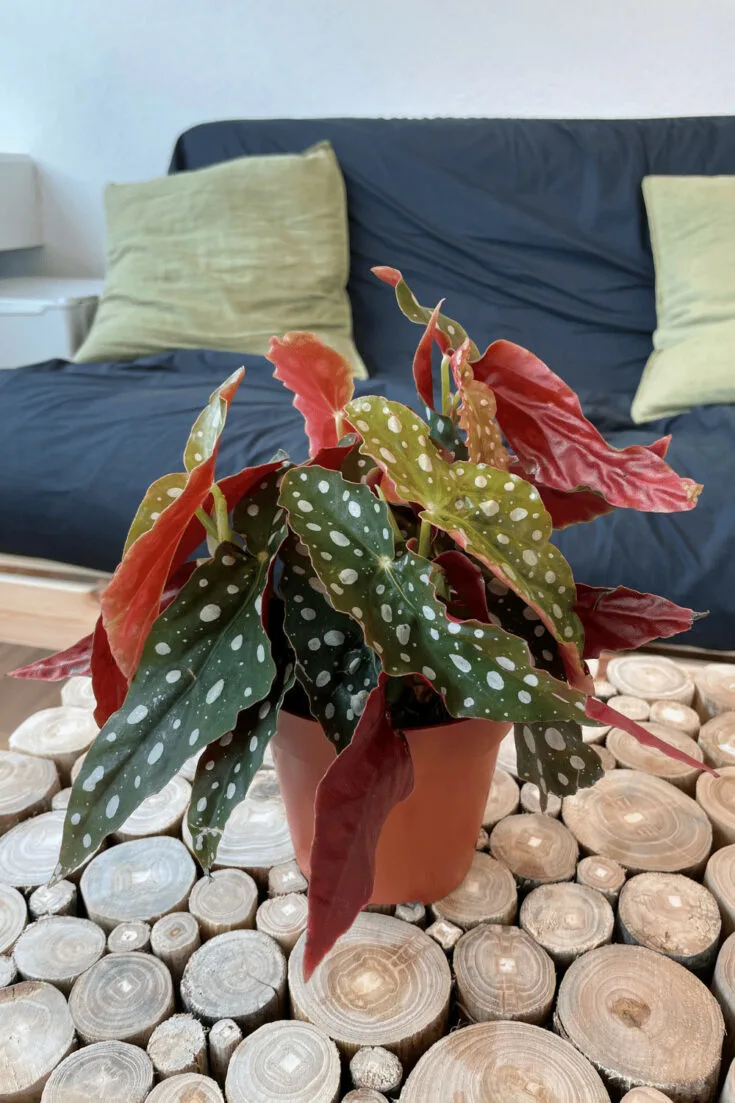
Cane Begonia Light Requirements
This plant prefers bright indirect sunlight (filtered light) to thrive. Bright light is considered light between 10k – 20k lux or 2k – 5k foot candles. Avoid direct sunlight, as it might scorch the leaves. They do not grow well in low light and will not bloom.
In lower-light situations, the leaf color is less intense. Your plant will become leggy and will not flower.
Higher light levels will promote the intense green coloring and the white dots.
It prefers a bit more shade than most indoor plants.
Placing it in a bright, well-lit room away from direct sunlight is advisable to keep those silvery-white olive leaves vibrant.
You can use a light meter to measure the light your spotted Begonia gets.
Let me tell you one thing. I was shocked to find out how little light my plants receive indoors—even the ones relatively close to a window or a light source. Light falls off so quickly.
If you like to take your plant outside during summer, place it in the shade away from direct sunlight.
Do not put your grow light too close, though, and follow the guidelines in the instruction manual.
If the leaves appear scorched, move your Begonia to a less sunny part of the room or further away from the grow light.
Too much light will be indicated by burgundy leaf color, whereas a healthy plant with optimal light will have light green to dark green leaf uppersides.
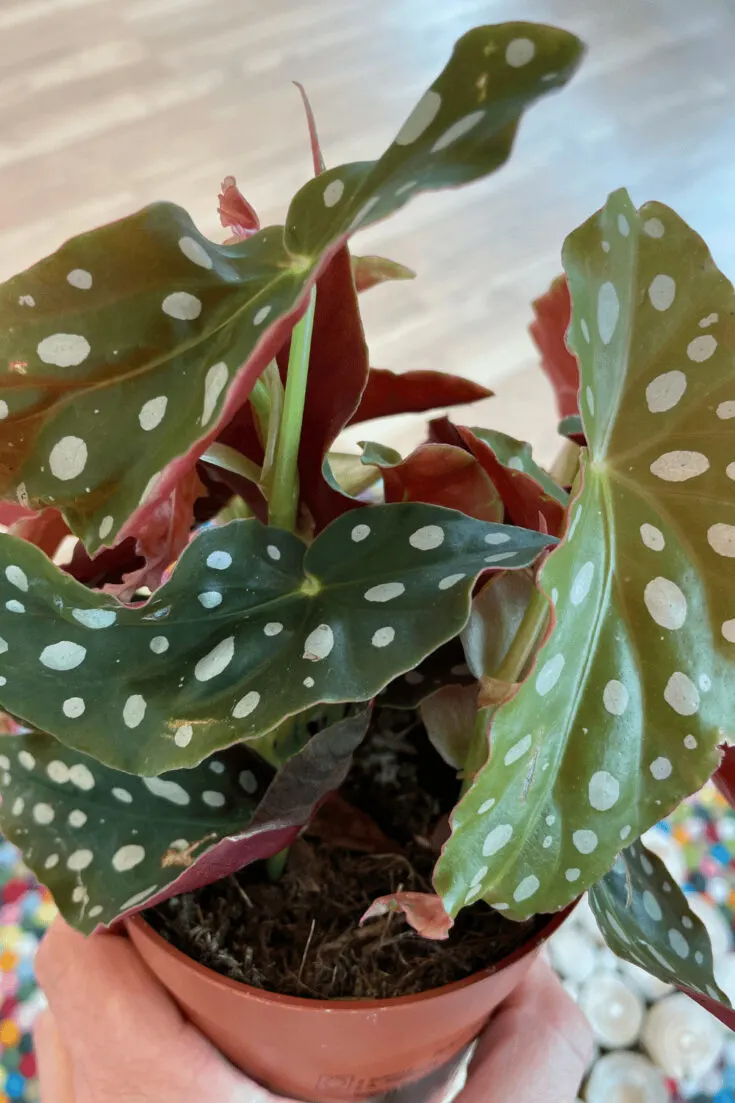
Watering
Keep the soil slightly damp at all times. Water about once a week when the soil is still slightly moist to the touch. Avoid soggy soils, as this will lead to root rot. Make sure the soil never becomes completely dry.
These houseplants are not drought-resistant. Their root system is thin and finicky.
Let this Begonia almost dry out between waterings, as these plants do not tolerate soggy soil.
Consistent moisture is key for a happy maculata.
Striking the right balance when watering the Begonia maculata wightii is challenging.
The soil should be a bit damp but not overly wet. This is because it is highly susceptible to root rot.
Before watering, you should test the soil for dampness by dipping a finger into the soil- the top portion should be dry to about an inch deep.
If you are unsure whether to water it, it is better to err on caution until the leaves start showing signs of wilting, indicating little water left in the pot.
When watering it, pour water directly onto the soil, ensuring the leaves remain dry.
Temperature
Its ideal temperature is between 67 to 70 degrees Fahrenheit (18 to 22 degrees Celsius). Begonia maculata is hardy until USDA Hardiness Zone 11.
This might be a tall order for anyone in temperate climates, such as Europe. However, rest assured that temperature-related damage does not happen until temperatures drop to less than 60 degrees Fahrenheit (15 degrees Celsius).
When kept indoors, ensure that this Begonia is not too close to cold, drafty windows and far away from radiators and air conditioners, as these conditions will damage the foliage.
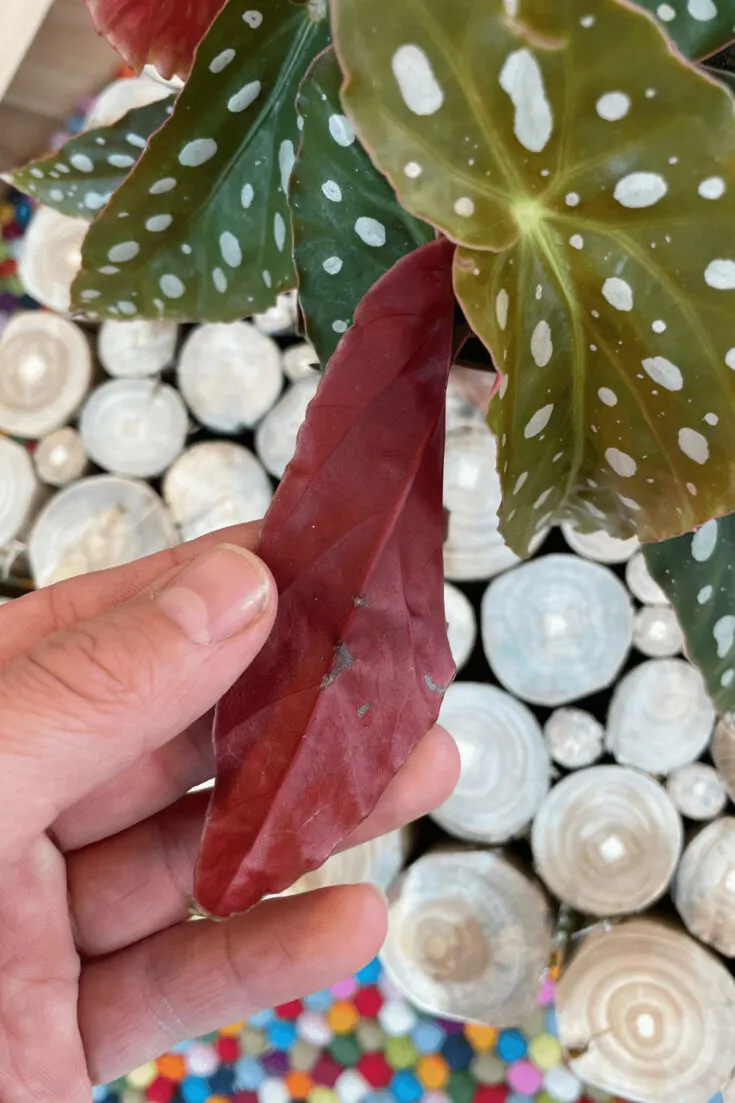
Humidity Needs
It requires high humidity levels above 50%. Bathrooms, given the right level of light, are a great choice, as well as a terrarium. Alternatively, use a humidifier. These are rainforest plants.
Alternatively, you can set it in your favorite room, but place a saucer of water near it to ensure it creates the required humidity as the water evaporates.
Caution: Do not place the pot inside the saucer of water because this could make roots overly wet. You should also ensure the leaves remain dry because the plant is susceptible to powdery mildew.
A humidifier is a great way to increase humidity and ensure constant high humidity levels for your plants.
I have reviewed and listed the best humidifiers for houseplants in a blog post.
When and How Often to Fertilize
Fertilize every two weeks in Spring and Summer using a balanced fertilizer.
For best results, use half the required dosage of water-soluble fertilizer according to package instructions.
If the package says you should use one cup of water to dilute the solution, use two cups instead.
Fertilization must be done only once every two months in Autumn and Winter. Wing Begonias have a dormancy period. It, therefore, needs to be fertilized less.
An insider tip from me to you is to use worm castings. This is a great way to fertilize your plant.
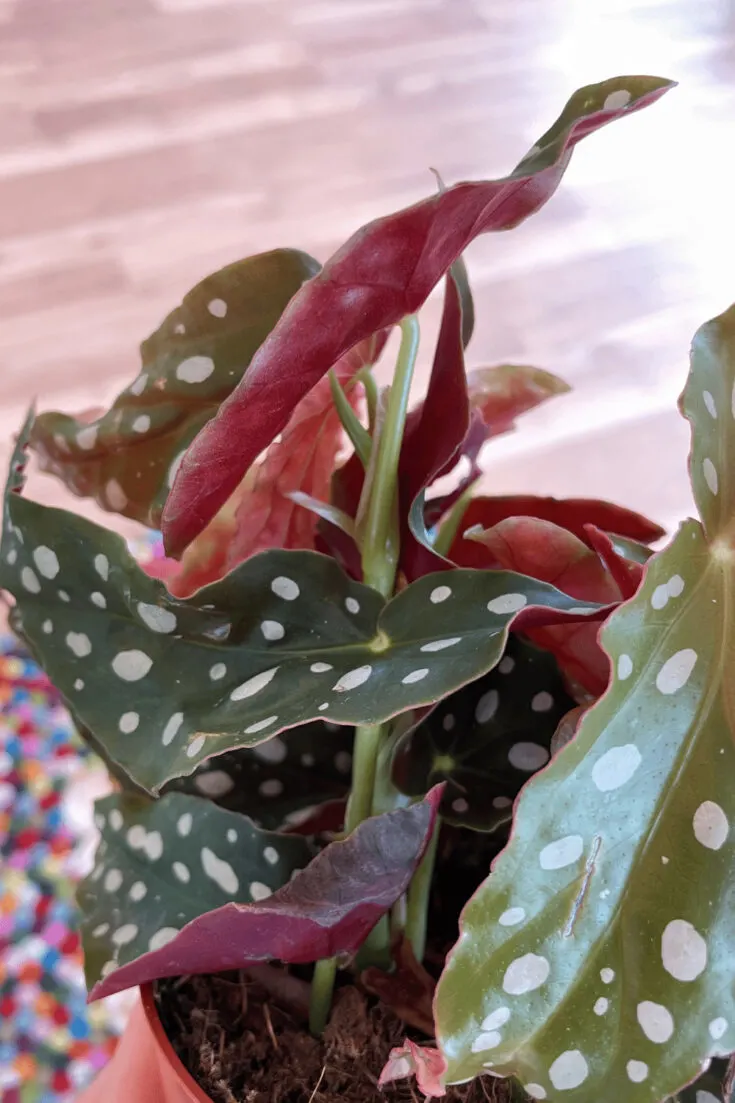
Star Begonia Propagation
This indoor plant is relatively easy to propagate through cuttings. Propagation is best done during the heat of winter when blooming is minimal.
Cut off a stem with no flowers below the bud using scissors or pruning shears. Remove the lower leaves and dip them in a jar of water.
Let it remain inside the jar until roots start to form. After that, plant it in sandy, loamy, and clay soil. Water it so that the soil is lightly moist but not overly soaked.
Propagation
You can grow new plants from seeds, but propagating from cuttings is the easiest and most rewarding way gorwing them. You can even add rooting hormones to speed up the rooting process.
Propagation from leaf cuttings
You only have to snip a few fresh leaves from your plant to make new Polka dot Begonia plants from cuttings.
Lay the leaves flat upside down and slice them into neat wedges with a clean, sharp knife. (Be extra careful if you are using a razor blade).
Make sure you have a vein in each wedge piece. You can make a lot of baby Begonia plants using this method.
However, you do not have to slice the leaves up for just a few new plants.
Simply snip out some leaves from the main plant leaving at least 1 inch of petiole still attached to each leaf (the petiole is the stalk that extends from the leaf and attaches it to the stem of the plant).
Fill a small pot with well-draining soil to make a nursery for your leaf cuttings. You can even use a mixture of vermiculite, peat, perlite or pumice, and moss.
Stick the leaf wedges or petiole stalks into the soil or moss, and store the pot in a bright, warm plastic bag away from direct sunlight.
Make sure the soil in the pot has a little water to keep the cuttings moist, but do not overwater it, as this could cause rot.
You will start seeing roots about three to four weeks after planting them.
After six weeks, your baby plants should be ready to move to your favorite pot or garden.
Alternatively, you can make new Begonia plants by propagating your cuttings in a glass with fresh, clean water.
Food jars are the ideal size for this type of propagation. A single jar can accommodate several cuttings.
Once the roots are about half an inch long, your cuttings can be transferred to new pots.
Propagation from stem cuttings
Begonia maculata will also grow from stem cuttings, commonly known as rhizomes. Rhizomes are long, thick stems that can be grown under the soil.
Start by cutting a rhizome piece about 1 inch long (2.5 cm) with multiple nodes and press it gently into a pot with a mix of well-draining soil or moss.
Get fresh young stems. Once your plant reaches maturity, most stems will become woody. Such stems should be avoided when propagating Begonias.
You can also use the water propagation method.
Just like their leaf counterparts, ensure they remain moist but not wet.
Keep them in a warm, well-lit place away from direct sunlight until the roots form in about 5 to 7 weeks.
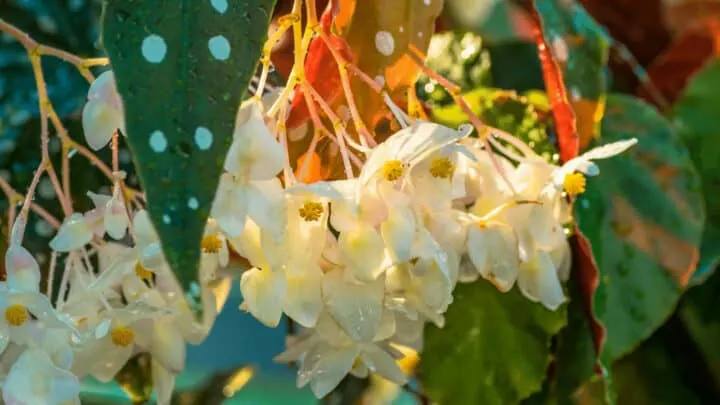
Propagation from seeds
Growing the Polka dot Begonia from its seeds is more challenging and takes time.
Remember that if the seeds are from hybrid plants, you will not get baby begonias that are a replica of their parents.
This is because hybrids are a mix of different varieties. You may not even get any baby plants if you use sterile hybrids.
Read more about Begonia maculata propagation.

Flowering
It produces a cluster of white flowers with yellow centers and single stems—the Maculata flowers between Spring and Autumn.
You will be rewarded with beautiful white to pale pink flowers in late winter and throughout the spring season.
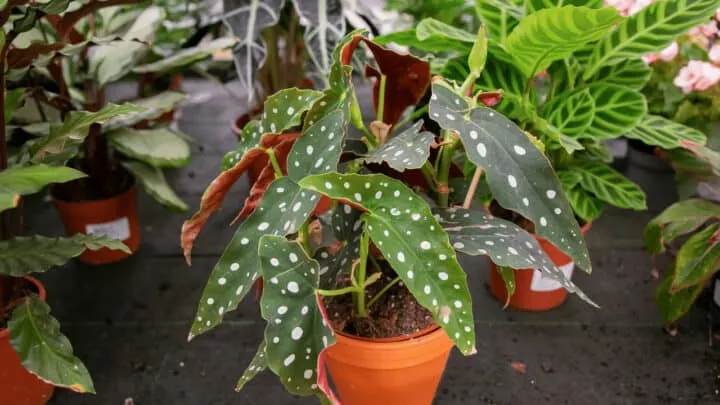
Growth
It grows to about 4.9 feet tall (1.5 m). The leaves are usually asymmetric, extending to approximately 7.9 inches (20 cm). The stems are bamboo-like. Angel Wing Begonias are vigorous growers.
The upper surface of the leaf is dark green with silvery-white spots, while the reverse is red. Young leaves are pink to maroon in color. The new growth changes color from light green to dark green over time.
Flowers usually form in single clusters and are white to pale pink. You should remove any wilted flowers regularly to stimulate the growth of new ones. Cane begonias can get leggy and will become bushier when cut back.
Use stakes to support the stems of Silver Polka Dot plants.
Prune it regularly to create a beautiful bushy shape. Spring and summer are usually the best seasons to prune it.
Snip back the overgrown branches above the bud by about half its length. New branches will form from the buds to create a pleasant thick appearance.
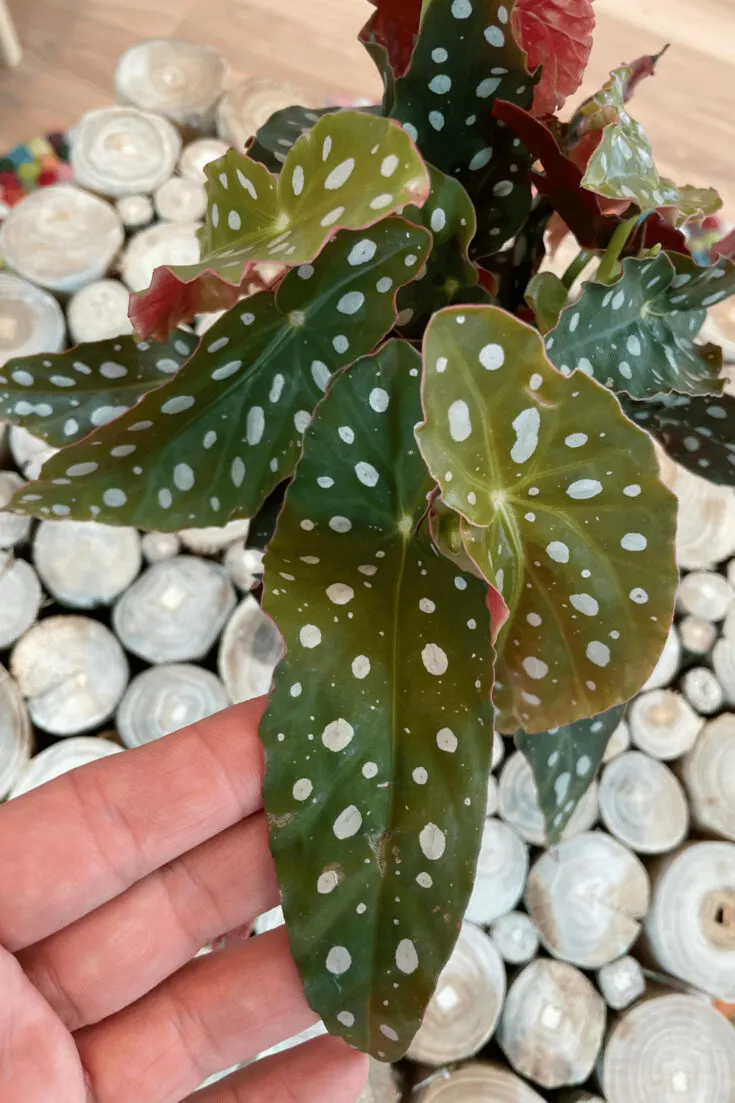
Potting
This houseplant likes to be pot-bound and thus requires smaller pots than most other houseplants. Regular repotting with fresh soil is also essential during the first years of its life to ensure it gets sufficient nutrients. Make sure the pot has drainage holes so excess water can escape.
Correct potting is an integral part of the growth cycle. The right pot size and type determines, to a large extent, whether the plant will thrive or not.
The best time to repot is during spring. When repotting it, choose a pot size larger than the current one. An ideal container is one with good drainage and excellent moisture-holding capability.
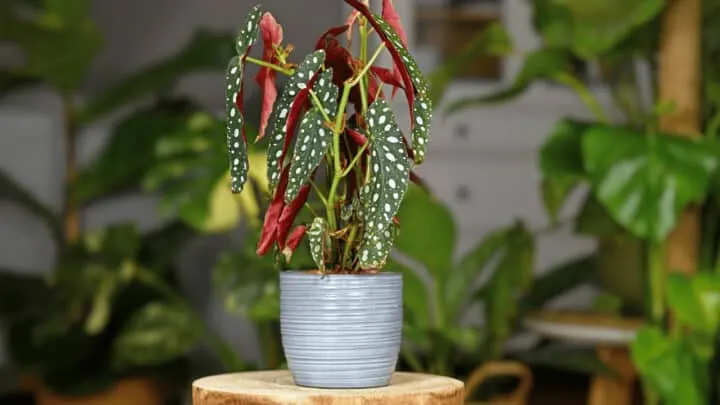

Propagation from seeds
Growing this plant seeds is more challenging and takes time.
Remember that if the seeds are from hybrid plants, you will not get baby Begonias, a replica of their parents.
This is because hybrids are a mix of different varieties. You may not even get any baby plants if you use sterile hybrids.
Begonia Care Tips Outdoors
You can always take your plant outdoors, especially during summer, to boost it in the sun. Alternatively, you can choose to keep it indoors all year round.
If you take it outside for a little sun, bring it indoors before it gets too cold.
They cannot withstand frost and will wilt and die as soon as they are exposed to frost.
Bringing it back indoors when temperatures fall below 60 degrees Fahrenheit is advisable.
They do not like cold temperatures, and the sudden shock after such a temperature change is too much for them.
Ensure to take them indoors in time, and they will thrive and survive beautifully.
According to the University of Connecticut, it can be grown outdoors in USDA zones 10b-11.
How to Water
Taking care of the Eyelash Begonia can be a big challenge because they are extremely sensitive to water.
I can confidently say overwatering is the leading issue.
As a rule, only water them when they show signs of wilting. Allow the soil actually to dry out in between the waterings.
To check the moisture content, dip a finger into the soil about an inch deep before adding water. Only water it if the soil feels almost dry.
If you have a hard time when it comes to watering your plants, I recommend buying a soil moisture gauge for better accuracy.
On the same note, be careful about how you water your plant. The leaves and stems should never get wet.
While the Maculata is not as sensitive as other indoor plants like the African Violets, it is highly susceptible to damage if wet.
Always water your plant from the bottom rather than the top to avoid such problems.
Fill a tray with water and allow the plant to soak it up through its porous base.
Do not let your plant sit in the water for too long. Just let it soak water up to the point where the soil is a little moist. You can then discard the remaining water.
What Does the Fancy-leafed Begonia Look Like?
It is a gorgeous perennial plant that blossoms with white to pale pink flowers up to three times a year.
The upper side of the leaf is green, forming a drastic contrast with the red-Bordeaux reverse.
You’ll also notice that its evergreen leaves evolve from olive to emerald green and are beautifully dotted with bright spots along the leaf’s veins.
Every season is a show season for the Polka dot Begonia, though you can expect it to flower mainly from late winter until spring.
Its beautiful white flowers sprout in clusters from a single stem.
The Origin
The beautiful Polka Dot plant belongs to the long line of Begonia species. It was first discovered in Brazil in 1982 by an Italian researcher.
However, it is originally native to Mexico, Asia, South Africa, and Central America. It grows best in moist subtropical and tropical climates, but indoor species do well in cooler environments.
This plant undoubtedly shines as an exquisite indoor treasure.
Its scientific name Maculata is derived from its whitish spots, while the other name Begonia is derived from the shape of its stem.
Where to buy
You can buy it directly from Amazon, Logees, or Steves Leaves.
How much does it cost?
The average price for a nice-sized plant is $20.
Is Begonia maculata toxic?
It is toxic to pets such as cats and dogs. It can still cause irritation and vomiting as it contains soluble calcium oxalates, according to ASCPA. Therefore make sure to keep it away from small kids and pets.
Diseases
Brown Spots
Brown and black spots on leaves are caused by fungus or bacteria. The main reason is overwatering. Remove any leaf section or leaves with brown spots and check the roots.
If the roots are mushy, remove the mushy parts and rinse the roots with water. Exchange the potting soil and disinfect the pot.
Dry Leaf Tips
Brown tips are an indicator of underwatering or insufficient humidity. In addition, dry leaf tips can occur because of chlorinated tap water.
The best way to avoid crispy brown leaf tips is frequent watering, humidity above 50%, and rainwater or tap water allowed to sit for at least 12-24 hours.
Water thoroughly when watering.
Yellow Leaves
Yellow leaves can be a sign of over- or underwatering. Leaves also turn yellow because of pest infestations.
To avoid yellow leaves, stick to a consistent water regimen and neither over- nor underwater your plant.
Excess Water
Excess water will lead to pythium root rot, affecting the whole plant.
Ensure your Angel Wing plant has a pot with drainage holes, and refrain from watering when the soil is still humid.
Bacterial Leaf Spot
Small, brown, or black water-soaked spots on leaf blades indicate bacterial leaf spots. Bacteria cause it and might lead to the collapse of a leaf if more spots occur.
Bacterial leaf spots usually start on older leaves, according to the University of California.
Copper fungicides and sulfur can be sprayed weekly to prevent the disease.
Dropping Leaves
A common sign of Begonia maculata being unhappy is leaf drop. The causes are either over- or underwatering, insufficient or too much light, temperature fluctuations, and extreme temperatures.
Fungal diseases
Common fungal diseases on Cane Begonias are septoria leaf spot (Septoria lycopersici) and Botrytis blight or blotch.
Circular water-soaked spots are forming mostly on your plants’ leaves.
Ensure good ventilation and air circulation. Remove debirs often and do not overwater. This helps to prevent fungal diseases. You can treat your plant with a copper fungicide if fungi are already present.
Pests
Spider Mites
Spider Mites are a type of spider and are not insects. They are round and reddish-brown. Since they are tiny, they are hard to spot with bare eyes. These are common pests that affect Begonias indoors.
Spider mites have a soft body and can be squished and removed using cotton swaps with rubbing alcohol.
They damage plant tissue and are mostly found on the underside of leaves.
To get rid of spider mites, use an insecticide. Alternatively, use neem oil.
Here is how to revive the plant.
Thrips
Thrips are some of the worst plant pests you can get. At the larvae stage, these insects are small and white. Once they are larget they become brown and black. Thrips have a longish body. They suck the plant sap and deprive your Begonia maculata of essential nutrients.
To get rid of thrips, use a systemic insecticide. All other forms of biological pesticides did not work for me. An alternative treatment you can try is beneficial nematodes.
Mealybugs
Mealybugs are white insects with soft round bodies. They look like cotton balls. You can eliminate them using a cotton swap drenched in rubbing alcohol.
Ensure to remove mealybugs immediately once you spot them. Otherwise, they grow in numbers rapidly and become hard to eliminate.
Whiteflies
Whiteflies are winged insects. They have soft bodies. They suck plant sap using their mouth parts. They damage leaves. Your plants’ growth stunts, and leaves wilt and die.
Spritz your plants with water to jet these flies off. What also works based on my experience is using d dishwater soap and some drops of rubbing alcohol diluted in water.
Aphids
Aphids are 1 to 7mm (¼in or less) long. They have pear-shaped bodies. The color ranges from brown to black. They are easy to spot with the eye. These insects suck plant sap.
To get rid of aphids, spray diluted dishwater soap with water on them. This dissolves their bodies. Aphids can also be squished and plucked.
Varieties
There are multiple types of Begonia macualta:
- Begonia maculata Silver Spot
- Cane Begonia Torch
- Begonia maculata Flamingo Queen
- Cane Begonia Albo-picta – rosea
- Begonia maculata Raddi
- Cane Begonia Coccinea
- Cane Begonia Lucerna
- Begonia maculata Medora
- Begonia maculata Annan Grace
- Cane Begonia maculata Mrs Hashimoto X Maculata
- Cane Begonia Maculata Albo-picta
- Cane Begonia Sinbad
- Begonia The Wiz
Frequently Asked Questions
How do you care for an Angel Wing Begonia?
To care for an Angel Wing Begonia provide well-draining soil. Keep the temperature between 67 to 70 degrees Fahrenheit (18 to 22 degrees Celsius). Water once a week when the top 1 inch (2.5cm) of soil is almost dry, and keep it slightly moist. Bright indirect light between 10k – 20k lux or 2k – 5k foot candles is best. Humidity should be above 50%.
Is Begonia maculata hard to care for?
Begonia maculata is not hard to care for, but it isn’t the easiest plant to care for either. They are fussy if they get too much sunlight or if you keep them too wet or dry. If these aspects are in check, it is not difficult.
Is the Begonia maculata rare?
Begonia maculata is not rare. Although you cannot buy it in every online shop or garden center, it is readily available in most countries.
Should you mist an Angel Wing Begonia?
You should not mist your Angel Wing Begonia. Misting keeps leaves dry for too long if insufficient air circulation is provided. In addition, it does little for the overall humidity levels in the air. Put it close to other plants or provide a pebble tray filled with water underneath.
How do I get my Begonia maculata to flower?
Begonia maculata flowers in spring and summer. Providing sufficient fertilizer every two weeks in spring and summer. Keep the soil slightly moist and provide bright indirect sunlight to get your Begonia to flower.
Is Angel Wing Begonia the same as Begonia maculata?
Angel wing begonia is used as a synonym for Begonia maculata. However, there are multiple Begonias with angel-wing-shaped leaves called Angel Wing Begonia, such as Begonia Splash Splash, Begonia Silver Wings, Begonia Esther Albertine, and many more.
Are there different types of Begonia maculata?
There are different types of Begonia maculata. They all look very similar and are hard to distinguish.
How fast does Begonia maculata grow? This Begonia has a fast growth rate
It is a fast grower producing leaves almost weekly. It can grow up to 12 inches per growing season (30cm).
How to Grow Begonia maculata
Maximize the health of your Begonia Maculata with these care tips: Place in a well-lit area near an east- or west-facing window, providing 10k – 20k lux. Use well-draining sandy clay and loamy soil. Water once a week, allowing the top inch to dry. Maintain a temperature range of 65-86°F (18-30°C). Keep humidity levels at 50% or higher. Trim regularly for shape and remove dead foliage. Propagate easily with stem cuttings. Fertilize every two weeks in spring/summer and every two months in autumn/winter.

Daniel has been a plant enthusiast for over 20 years. He owns hundreds of houseplants and prepares for the chili growing seasons yearly with great anticipation. His favorite plants are plant species in the Araceae family, such as Monstera, Philodendron, and Anthurium. He also loves gardening and is growing hot peppers, tomatoes, and many more vegetables.

